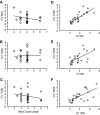Visuospatial working memory capacity predicts the organization of acquired explicit motor sequences
- PMID: 19357338
- PMCID: PMC2694099
- DOI: 10.1152/jn.00006.2009
Visuospatial working memory capacity predicts the organization of acquired explicit motor sequences
Abstract
Studies have suggested that cognitive processes such as working memory and temporal control contribute to motor sequence learning. These processes engage overlapping brain regions with sequence learning, but concrete evidence has been lacking. In this study, we determined whether limits in visuospatial working memory capacity and temporal control abilities affect the temporal organization of explicitly acquired motor sequences. Participants performed an explicit sequence learning task, a visuospatial working memory task, and a continuous tapping timing task. We found that visuospatial working memory capacity, but not the CV from the timing task, correlated with the rate of motor sequence learning and the chunking pattern observed in the learned sequence. These results show that individual differences in short-term visuospatial working memory capacity, but not temporal control, predict the temporal structure of explicitly acquired motor sequences.
Figures





References
-
- Ashe J, Lungu OV, Basford AT, Lu X. Cortical control of motor sequences. Curr Opin Neurobiol 16: 213–221, 2006. - PubMed
-
- Baddeley A, Logie R, Bressi S, Dellasala S, Spinnler H. Dementia and working memory. Q J Exp Psychol Hum Exp Psychol 38: 603–618, 1986. - PubMed
-
- Beilock SL, Carr TH. When high-powered people fail - working memory and “choking under pressure” in math. Psychol Sci 16: 101–105, 2005. - PubMed
-
- Boyer M, Destrebecqz A, Cleeremans A. Processing abstract sequence structure: learning without knowing, or knowing without learning? Psychol Res 69: 383–398, 2005. - PubMed
Publication types
MeSH terms
Grants and funding
LinkOut - more resources
Full Text Sources
Medical

